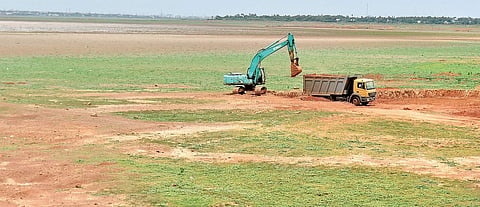

At a time when Chennai is reeling under one of the worst water crises, and is getting water delivered by trains and tankers from neighbouring districts, a State agency has sought permission to build an industrial zone right on the catchment area of the Red Hills reservoir, a primary source of water for the city.
The Small Industries Development Corporation (SIDCO) has applied for reclassification of 53 acres of the catchment area to build an industrial zone for women entrepreneurs. The application, according to officials, was submitted to the Chennai Metropolitan Development Authority on August 3.
Spread across 4,500 acres, the Red Hills reservoir is one of the largest water sources for the city. With a total capacity of 3,300 million cubic feet, the reservoir has been providing water to the city even in the times of drought. A portion of Krishna river water released from Andhra Pradesh is also stored in this reservoir.
The catchment area surrounding any reservoir is crucial since run-off rainwater will reach the storage point as small streams or creeks through the catchment area. For this to happen, the area must be bereft of any construction which might cut off its flow. Experts say encroachment on this area would ultimately result in floods like the one the city witnessed in 2015.
This will also reduce the amount of rain water the reservoir receives. The latest attempt by the industrial corporation is not an isolated incident. Comparison of satellite images from 1984 and 2018 accessed by Express (see image) shows that many constructions have come up in the catchment area over the years.
“Satellite images from the 1970s show that there has been a massive reduction in Chennai’s blue and green cover. Many of the lakes have been destroyed by various arms of the government in the past in order to reduce the costs related to land acquisition,” said Raj Bhagat Palanichamy, a remote sensing expert from World Resource Institute, India.
When Express contacted the industrial corporation, the officials confirmed the plan. “For obtaining a bank loan, we need a layout approval from the CMDA. For this purpose, we applied for reclassification of its land use. But we will not touch any part of the reservoir and the space we are taking up has no streams. We won’t be obstructing any kind of water flow to the reservoir,” said an official from SIDCO, who didn’t want to be named.
Environmental activists say such developments would help in legalising encroachments on waterbodies. “Parties that have an objection to the said reclassification are never called for a meeting with the authorities,” said David Manohar, an activist from the Arappor Iyakkam.
On the other hand, the CMDA has clarified that though they received many applications for reclassifying waterbodies, many were rejected.
“The construction of Semmencherry police station on a waterbody in Sholinganallur was the only exception as that piece of land was originally classified as a road. We don’t have the authority to change the land use of any waterbody or poromboke land, as it’s a violation of the High Court orders. Only the state government can do so, not the CMDA,” says Rajesh Lakhoni, member-secretary of the CMDA. He was transferred later in the day.